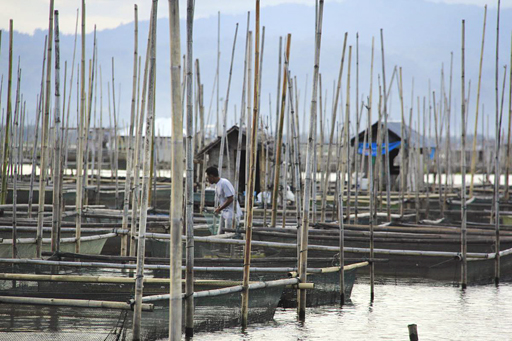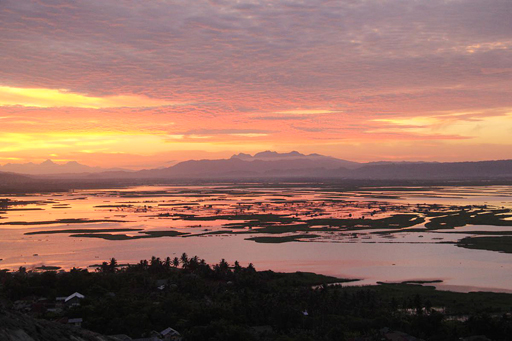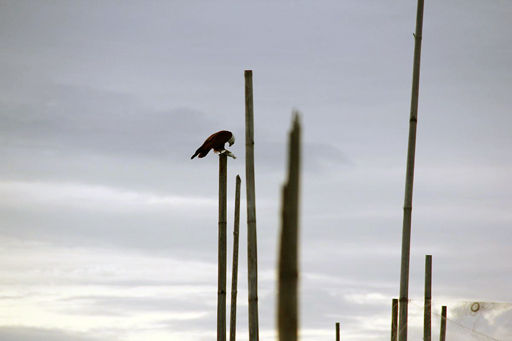facebookeb
IndoForum Senior A
- No. Urut
- 210735
- Sejak
- 9 Jan 2013
- Pesan
- 7.471
- Nilai reaksi
- 96
- Poin
- 48

You might think that it is natural, but you’d be wrong. It is a man-made phenomenon, more specifically, it is a work of art titled Lahilote. Taking the form of a huge foot, the installation was created by artist Iwan Yusuf, 31, in a solo display as part of what he calls a land art project.
Iwan, a native of Gorontalo, has turned Limboto into a giant canvas for an exhibition called “Menghadap Bumi”, or Facing the Earth, out of his apprehension about the lake’s condition. “It’s a project of reunion and concern over environmental damage in Gorontalo.”
Henkpublica, an arts and literary event organizer in Surabaya, East Java, welcomed Iwan’s concept and partially funded the work. Iwan promptly invited some of his old friends back home in his village (he has lived in Java for the last 14 years) and cooperated with local fishermen to create the installation.
Iwan’s team started work on Aug. 12, carrying over half a million bamboo stems by boat. Stuck to the bottom of the lake, these stems served as the “sketch” of the picture, which was “painted” by filling the bamboo pattern with hyacinths from motorboats.

“At noon, strong winds, high waves and rain can come at any moment,” said the artist, who began his career as a painter of portraits. Using water as a medium made it more complicated to determine the proportions and accuracy of the image, he added. “Water leaves no marks, so more accurate calculations are needed.”
The sole of the foot, measuring 500 meters by 190 meters and facing southeast, was derived from folklore familiar to the community around the lake, which is has been growing more and more shallow.
The legend has it that Lahilote, a young man, stole the scarf of an angel taking a bath in Lake Limboto, whom he later married.
One day, the angel recovered her scarf and returned to heaven. Lahilote chased her by climbing a rattan tree and stayed with her for a while until he finally fell back down to the earth with his body divided into two.
One of his feet is believed to have dropped in Pohe, a coastal village in Gorontalo.
His other foot is said to have plunged in any of three other places including Botuliodu village in Gorontalo regency. “The sole constitutes a symbol to indicate how shallow Lake Limboto has now become — only as deep as the footprint of Lahilote,” Iwan said.
Karmin Baruadi, a lecturer of culture and literature at Gorontalo State University, says there are several pieces of folklore that have sprung up about the lake.
Local residents believe that around the 17th century, people living around Lake Limboto witnessed the signing of a peace agreement by two warring leaders: King Popa in Limboto and King Eyato in Gorontalo.

“Many hyacinth areas were blocked by fishermen to trap fish, so we couldn’t use them all,” Iwan said. Working for up to five hours a day, the team expected to finish the work in less than two weeks. It took three.
“At noon, strong winds, high waves and rain can come at any moment,” said the artist, who began his career as a painter of portraits. Using water as a medium made it more complicated to determine the proportions and accuracy of the image, he added. “Water leaves no marks, so more accurate calculations are needed.”
The sole of the foot, measuring 500 meters by 190 meters and facing southeast, was derived from folklore familiar to the community around the lake, which is has been growing more and more shallow.
The legend has it that Lahilote, a young man, stole the scarf of an angel taking a bath in Lake Limboto, whom he later married.
One day, the angel recovered her scarf and returned to heaven. Lahilote chased her by climbing a rattan tree and stayed with her for a while until he finally fell back down to the earth with his body divided into two.
One of his feet is believed to have dropped in Pohe, a coastal village in Gorontalo.
His other foot is said to have plunged in any of three other places including Botuliodu village in Gorontalo regency. “The sole constitutes a symbol to indicate how shallow Lake Limboto has now become — only as deep as the footprint of Lahilote,” Iwan said.
Karmin Baruadi, a lecturer of culture and literature at Gorontalo State University, says there are several pieces of folklore that have sprung up about the lake.
Local residents believe that around the 17th century, people living around Lake Limboto witnessed the signing of a peace agreement by two warring leaders: King Popa in Limboto and King Eyato in Gorontalo.
Into the bluish lake water, they tossed two interlinked rings and their weapons. If the rings were ever found, according to the legend, the war would resume.
Another myth, according to Karmin, has it that Lake Limboto was once a vast sea. When the waters receded, forest and shrubbery emerged along with clear water springs where four angels from heaven bathed.
Around the lake, citrus trees later grew in the heavenly forest, filling the air with their fragrance, giving the lake its local name: Bulalo lo Limu o Tutu (The Lake of Citrus from Heaven) — hence the name Limboto.
Iwan combined water hyacinths and local mythology to induce public response to the intricate issue of Lake Limboto, fine arts curator Hendro Wiyanto said.
According to Iwan, the water painting is just a way of making people aware of the need to rescue Lake Limboto, appealing to them to see what’s on display and find out the message behind it.
“In Indonesia, environmental art has been practiced since the mid-1980s, although there has been declining attention to this branch. Meanwhile our environment is in fact getting ravaged,” said Hendro, who visited Gorontalo to watch Iwan’s show in September.

According to the Gorontalo provincial environment, research and information technology agency (Balihristi), the lake was once a lagoon connected to the sea by the Bolango and Bone Rivers. Tectonic activity eventually separated the lagoon from the sea and created a freshwater lake.
Rugaya Biki, who heads the environment section of the Gorontalo Balihristi, said that Lake Limboto spanned 7,000 hectares and had an average depth of 30 meters in 1932, which had diminished to 4,250 hectares and 10 meters by 1961 and 3,000 hectares and 2.5 meters by 2008.
“Sedimentation and erosion caused the lake to become shallow, through agriculture without soil conservation, rampant logging in river upper reaches and environmentally adverse fish breeding,” he explained.
With proper management, the lake could supply clean water, provide plant and animal habitats, prevent natural disasters and produce biological resources and energy, besides offering recreation and sports facilities.
As time elapses, however, the ecology of Limboto has grown even more critical and created many problems. Apart from annual overflows, the lake has becomes an arena of struggle for fish breeding plots, with a large number of fish cages reportedly owned by officials.
When lake water drains away, part of the pool turns into a farm.
According to Balihristi, while 23 rivers used to flow into Limboto, today there is only one, the Biyonga River, that flows for the whole year.

While the regional government issued a regulation on the management of Limboto in 2008, there has yet been no solution. During the National Conference on Lakes in Bali in 2009, Lake Limboto was one of 15 rivers in Indonesia given prioritization for rehabilitation during 2015-2019.
Without serious and continuous handling to improve its conditions, Lake Limboto as the pride of Gorontalo people is predicted to disappear in 2025.
Meanwhile, Hendro was phlegmatic. “The problem of Limboto certainly doesn’t only involve the regional government.”
The Lahilote installation will be dismantled on Oct. 12.
